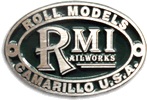World War 1 Trench Train |
Trench Locomotive, Pechot Materiel System, Artillery Crane and Side Tipper |
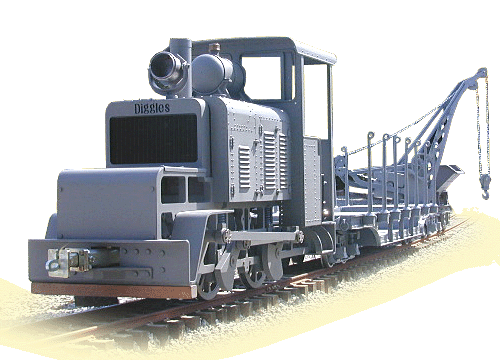
|
 |
The WW-1 narrow gauge trench train operation reproduced in 3.75" scale |
|
When rail fans discuss narrow
gauge railroads, conversation most often turns to Colorado's
famous 3-foot systems or Maine's unique "2-Footers".
Most do not realize that the largest narrow gauge operation
ever undertaken occurred from 1914-1918 on World War 1's Western
Front.
For the first time in history,
million-man armies faced each other across a front encompassing
multiple countries. This huge endeavor had an insatiable appetite
for ammunition, food, and material. A heavy duty road network
was years in the future, and cargo trucks were just beginning
to be developed. Military planners of the late 19th century turned
to lightly laid narrow gauge railroads similar to those used
so successfully on plantations in colonial areas of the world.
This technology was quickly adapted to the requirements of the
Western Front. More than 10,000 diminutive locomotives and uncounted
cars moved millions of tons of material forward to the trenches
and returned with tens of thousands of wounded soldiers. All
the major combatants - The United States, Great Britain, France,
and Germany - used very similar equipment and shared the same
60cm (23-5/8") gauge. Many U.S. companies such as Baldwin,
Alco, Davenport, Vulcan, Magor, Kilbourne&Jacobs, etc. produced
60cm equipment for all the allied countries in addition to a
significant amount of 75cm for Russia. At the end of the conflict,
most of this equipment quickly disappeared. Much was scrapped,
sold as surplus, or shipped to remote locations.
Click
to see more. >>>
The originals may be gone,
but you can recreate a bit of this history. RMI produces a select
range of this very unique railroad equipment. Since it is all
produced in authentic 3-3/4" scale, the units are large
and robust. They are accurately reproduced, utilizing original
designs and photographs of existing specimens, and assembled
with thousands of solid steel rivets.
|
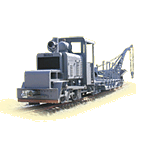 |
|
 |
WW1 Baldwin 50 HP Narrow Gauge Trench Locomotive in 3.75" Scale |
Baldwin 50hp Gas/Mechanical
Locomotive
While the majority of motive
power was steam driven, locomotives with Petrol/Oil burning internal
combustion engines made a significant debut. Less powerful than
their steam brethren, they had several unique advantages. They
required far less maintenance, needed very little water, and
could be shut down and easily restarted as the situation demanded.
Most importantly, they produced little smoke, thereby presenting
a less conspicuous target to enemy artillery.
Click
to see more. >>>
RMI offers an extremely accurate
and complete model of Baldwin's 50 hp Gas/Mechanical "Trench
Locomotive". It can be supplied as either an electric or
gas/hydraulic unit. Like the prototype, a nose mounted gearbox
drives a jack-shaft which is connected to the rear drivers through
steam engine style main rods. The front and rear drivers are
connected with side rods. This is a powerful, steady running
0-4-0, comfortably pulling heavy loads on very tight radius curves.
It has a very unique character that seems to make friends wherever
it goes!
|
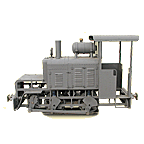 |
Pechot Materiel Transport System Cars in 3.75" Scale |
 |
| |
|
Pechot Materiel Transport
System
Captain Prosper Pechot's concept
of a highly modular system was based upon what he called "wagons".
(We would call these units completely independent trucks.) They
were heavily built with a very low center of gravity, and produced
in 2, 3, and 4 axle models with individual footplates, brake
wheels and rigging. On the 3 and 4 axle models, the wheels on
the inner axle(s) were flangeless, allowing the whole series
of trucks to negotiate very tight (25') radius curves. Used in
various combinations, these trucks could support 5 to 24 tons.
A number of different assemblies could then be placed place on
top of or between two trucks. The simplest were swivel bolsters
quite similar to logging bunks. Various frames were produced
to support pre-made track panels, artillery shells, and even
hundreds of loaves of bread! The most widely used combination
was an elegantly over-built drop frame well car and 2-four wheel
trucks. These chassis consisted of all steel, riveted frames
with numerous tie-down rings and stake pockets. The uniquely
shaped, forged steel stakes gave these cars a truly different
appearance. They could carry staggering amounts of heavy materiel
in their basic configuration or, with specialized bodies that
dropped into the stake pockets, become box cars, litter carriers,
troop transports, etc.
Click
to see more. >>>
These units are the ultimate
expression of the steel car builder's art. Their massive construction
and very low center of gravity make them some of the most stable
narrow gauge cars available. The basic unit can be quickly changed
into any of its many variants (heavy hauler flat car, troop transport,
box car, litter carrier, etc.), adding realism to any operation.
This same modularity also makes them very easy to transport.
|
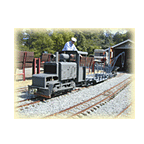 |
Artillery Crane |
 |
| |
|
Single Truck Artillery
Crane with Live Counterweight
This is one of the
strangest and most clever pieces of railway equipment ever devised.
The crane was carried on top of a 2-axle Pechot truck. It could
swivel 360 degrees, had a fixed height boom, and a hand cranked
lifting rigging winch. These cranes were specifically designed
to lift a specific load (artillery shells) of constant weight.
To keep the unit small and compact, the crane utilized a clever,
self-adjusting counterweight. As a load was applied, the weight
was pulled farther along a track opposite the boom to maintain
balance. When not deployed, this weight rolled back to a position
directly over the center of the truck, assuring the most stable
configuration for travel.
Click
to see more. >>>
All these features are completely
reproduced in RMI's model, including the main chain winch with
full gearing and ratchet control. Mounted on a prototypical Pechot
truck, this unit is a must for those seeking a most unique example
of narrow gauge ingenuity.
Note: A number of people have mounted this crane on the deck
of our 3-3/4" work cabooses. It's a great application!
|
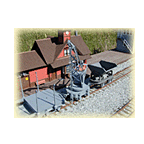 |
Side Tipper Dump Car |
 |
| |
|
2-Axle, 1 Cubic Yard Side-Tipper
Nearly identical versions of these diminutive, man-tippable cars
were built by every nation with narrow gauge railways. Originally
used in quarries, brick yards, peat bogs, and for road building,
these cars found numerous applications at the front. Besides
hauling many bulk materials and aiding in the construction of
right of way, they were sometimes pressed into service as personnel
transport.
Click
to see more. >>>
As with other RMI trench equipment,
these cars are constructed and operate exactly like the originals
and feature all steel, all riveted construction. A string of
these little beauties is one of the most attractive and authentic
consists available for the military, mining, or industrial narrow
gauge operator.
|
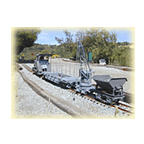 |
|
